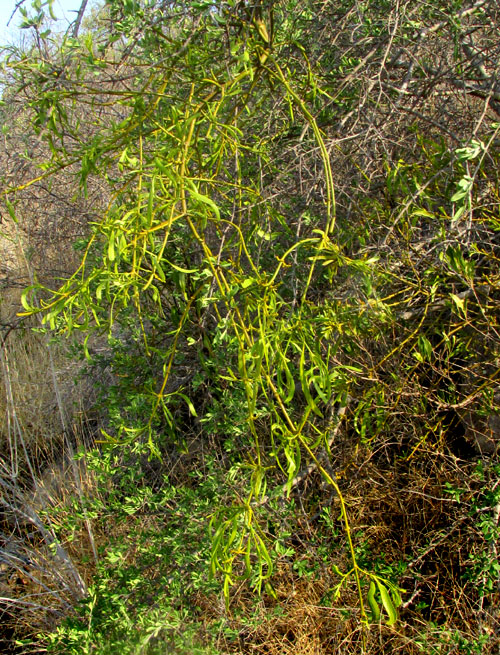Excerpts from Jim Conrad's
Naturalist Newsletter
entry dated May 22, 2022, issued from near Tequisquiapan, elevation about 1,900m (6200 ft), N20.565°, W99.890°, Querétaro state, MÉXICO
MISTLETOE ON DESERT OLIVE

On a Desert Olive tree, Forestiera shrevei, at the edge of a country road, the above mistletoe caught the eye because it was a yellowish green entanglement among a Desert Olive tree's silvery-green leaves. As mistletoes go, it was a fair sized one, and possibly a challenge to identify. It could be a challenge because several distinct kinds of mistletoe exist, and many species of the various kinds, mostly in tropical and subtropical regions. However, this individual bore mature berry-type fruits, and that would help:

Also, its leaves were especially long and slender, and all its parts were hairless, so these were all good field marks:

This species with its whitish, succulent fruits arranged in short spikes was recognizable as belonging to the same genus as the common mistletoes of eastern North America and Europe, the genus Phoradendron. Still of the possibly 240 Phoradendron species occurring worldwide, about 20 have been documented in our Bajío region of upland central Mexico, so we still had to "do the botany."
Many Phoradendron species are host-specific, meaning they're found on only particular kinds of plants. Often oaks and members of the Bean Family are preferred. For that reason, from the beginning I supposed that this mistletoe either was unusually narrowly adapted to live on plants related to the Desert Olive, a member of the relatively uncommonly occurring Olive Family, or else our mistletoe was an unusually broadly adapted and flexible species, one able to parasitize something as seldom encountered as Desert Olives.
In the end, our plants being hairless, bearing no special scales called cataphylls where its stems branched, its leaves having their particular size and shape, and living on such an uncommonly occurring tree as the Desert Olive, all pointed to PHORADENDRON BRACHYSTACHYUM, with no English name. The species occurs in uplands between 1300-2400m elevation (4200-7900ft) throughout Mexico into Guatemala.
Phoradendron brachystachyum, then, is among that kind of mistletoe unusually broadly adapted to parasitize many hosts. In fact, in much of Mexico it's considered the most commonly encountered species occurring on the broadest spectrum of trees. In Mexico City it's thought of as a problem on street trees, though normally mistletoes don't endanger their hosts. If large numbers occur on one tree, typically it's because the tree already had problems and its natural resistance to parasites was low.